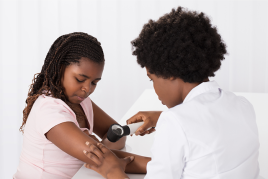Skin cancer types: Basal cell carcinoma overview
Basal cell carcinoma
What is basal cell carcinoma?
Basal cell carcinoma (BCC) is the most common type of skin cancer. When found early, BCC is highly treatable. Board-certified dermatologists have expertise in diagnosing and treating this skin cancer.
Is basal cell carcinoma contagious? No.
Basal cell carcinoma is the most common type of cancer
If you’ve been diagnosed with basal cell carcinoma (BCC), you have plenty of company. Basal cell carcinoma is the most common type of skin cancer. It’s also the most common type of cancer. Doctors diagnose millions of people with basal cell carcinoma every year.
Dermatologist examining patient for signs of skin cancer
You have a greater risk of developing this skin cancer if you have a lighter skin tone and seldom protected your skin from the sun throughout your life or used tanning beds.

People of all skin tones develop basal cell carcinoma. However, people who have light skin that rarely tans and tends to freckle, red or blond hair, and light-colored eyes have a greater risk of developing this skin cancer.
Before basal cell carcinoma develops, people with lighter skin tones often notice signs of sun damage on their skin, such as age spots, patches of discolored skin, and deep wrinkles. These signs can develop years before cancer.
Is basal cell carcinoma serious?
For most people, basal cell carcinoma is not life-threatening. This skin cancer tends to grow slowly. It seldom spreads to another part of the body. Even so, treatment is important.
Over time, basal cell carcinoma can grow wide and deep. It can spread deeply into the skin, wrap around nerves and blood vessels, and invade muscles and bone. When the cancer grows deep, it can change the way you look. For some people, this can be disfiguring.
When found early, this skin cancer is highly treatable. An early basal cell carcinoma can often be removed during an appointment with your dermatologist.
One common sign is a slowly growing, non-healing spot that sometimes bleeds. Basal cell carcinoma can also appear on the skin in other ways.
You’ll find the signs and symptoms along with several pictures of this skin cancer at, Basal cell carcinoma: Signs and symptoms.
Image
Getty Image
References
Cameron MC, Lee E, et al. “Basal cell carcinoma: Epidemiology; pathophysiology; clinical and histological subtypes; and disease associations.” J Am Acad Dermatol 2019;80:303-17.
Gloster HM, Neal K. “Skin cancer in skin of color.” J Am Acad Dermatol 2006;55:741-60.
Nouri K, Ballard CJ, et al. “Basal cell carcinoma.” In: Nouri K, et al. Skin Cancer. McGraw Hill Medical, China, 2008: 61-81.
Written by:
Paula Ludmann, MS
Reviewed by:
Carrie L. Kovarik, MD, FAAD
Natalie H. Matthews, MD, FAAD
Darrell S. Rigel, MD, FAAD
Last updated: 4/28/23
 Molluscum contagiosum: How to safely treat it
Molluscum contagiosum: How to safely treat it
 Biosimilars: 14 FAQs
Biosimilars: 14 FAQs
 Practice Safe Sun
Practice Safe Sun
 Relieve uncontrollably itchy skin
Relieve uncontrollably itchy skin
 Fade dark spots
Fade dark spots
 Untreatable razor bumps or acne?
Untreatable razor bumps or acne?
 Laser hair removal
Laser hair removal
 Scar treatment
Scar treatment
 Botox
Botox
 Free materials to help raise skin cancer awareness
Free materials to help raise skin cancer awareness
 Dermatologist-approved lesson plans, activities you can use
Dermatologist-approved lesson plans, activities you can use
 Find a Dermatologist
Find a Dermatologist
 What is a dermatologist?
What is a dermatologist?